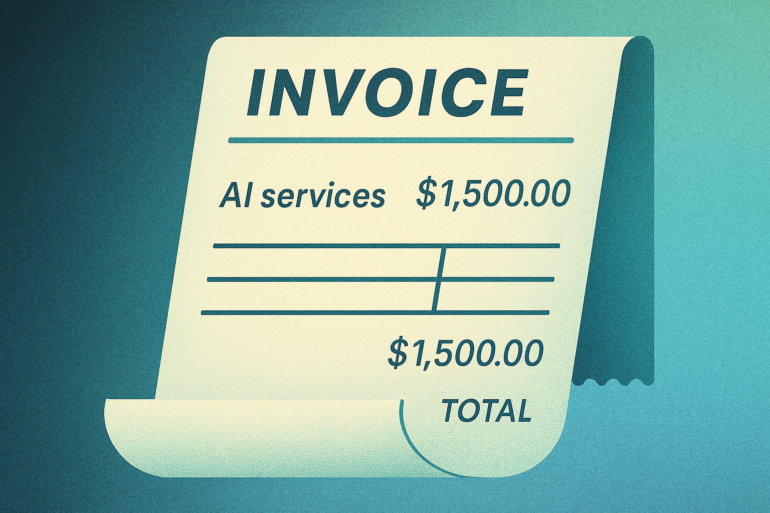AI startups are dumping per-seat pricing from the SaaS era in favor of outcome- or usage-based models.
The terms “customer support for financial services” and “sweepstakes” don’t typically go hand in hand, but, alas, here we are: In May, London-based Gradient Labs, which builds AI agents for customer support teams in financial services, announced the launch of a “$10k AI Customer Service Challenge.”
“We’re offering $10,000 to any company that tests us side-by-side with ANY other customer support automation solution – and we lose,” the company’s co-founder and CEO, Dimitri Masin, wrote in power-pose fashion. “Losing,” Masin clarified, means “the other solution needs to come within just 5 percentage points of our customer satisfaction scores (CSAT) and match or beat our automation rates.”
This challenge to buoy customer satisfaction comes at a time when business satisfaction with AI tools is wavering. A recent report from McKinsey highlights an ongoing “GenAI paradox,” wherein nearly 80% of companies have reported using generative AI tools, with a similarly large fraction of respondents claiming these tools have failed to meaningfully improve their bottom line. All buck, little bang. By putting Gradient Labs’s Seed-stage money where its mouth is, the challenge partially confronts (justified) systemic cynicism about the utility of automated tools.
Gradient Labs thinks rejiggering revenue flows can lead to a bigger bang for clients. It’s coupled its $10k challenge with a dynamic sticker price: Most of Gradient Labs’s clients are charged per successful resolution without human involvement, rather than per customer engagement with automated agents tout court. This pricing ploy, Gradient Labs hopes, can set it apart from competitors, and convince potential customers that its product can actually improve customer satisfaction as well as unit economics, even as other automated tools are underbaked or are falling short.
“Pricing per successful resolution makes that link to ROI or to value very, very explicit,” Masin, who also previously led neobank Monzo’s data-science efforts, told AI Nexus. If a human agent dedicates $5 to $10 per successful engagement through labor and time currently, then pricing a successful automated resolution at $1.50 makes the per-unit value of Gradient Labs’s tools easy to understand, he explained.
It also incentivizes Gradient Labs to improve over time and to expand the automated slice of clients’ customer-service pie. Charging per conversation or tokenization accounts for the denominator (total conversations), without factoring in the numerator (successful outcomes), this thinking goes.
“With success-based pricing, if we come in and we automate only 10% of their conversations, we feel like we’re earning only 10% of what we could be earning,” Masin said. “So that’s a very strong incentive alignment.”
Gradient Labs claims it can automate 50% of customer-service tickets out of the box without integrating meaningfully with customer data and proprietary workflows. But that only corresponds to a roughly 20% time savings, as those tickets are the most basic ones. A tiered pricing structure, in which Gradient Labs charges a higher price for successfully automating the more challenging tail of support tickets — similar to how higher tax brackets kick in at certain benchmarks — can encourage the agent developer to stick with customers, improve product, and legibly correlate automation to time as well as resource savings.
On the cost side, Masin said agent tools can’t follow a SaaS pricing model for fundamental economic reasons. Flat or per-seat pricing doesn’t account for the fact that increased usage on the client end directly correlates to increased costs on the product-provider end. “Our costs ramp up directly with the amount of conversations that we have,” he said.
But not every agent provider agrees with outcomes-based pricing logics. David Hsu, Founder and CEO of app-building platform Retool, which launched a beta-version AI-agent workflow product in March, thinks hourly-based pricing for the use of AI agents follows AWS’s adage most faithfully: “Charge based on what it costs to run, not what someone’s willing to pay.”
“Our own internal support agents solve most tickets in 60 to 90 seconds, which at our base rate of $1 per hour comes out to just about a penny per ticket,” Hsu told AI Nexus via email. “Compare that to $1+ per ticket with Salesforce or Intercom — that’s a 90% to 99% cost reduction.”
Hsu sees hourly pricing as the “stark and simple” way to calculate the ROI of an AI worker. “By pricing AI labor in human terms, we’re making the economics of automation transparent,” he said. “Every business knows their labor costs.”
Though Hsu argued that this pricing structure may be deflationary — “charging based on perceived value … often leads to inflated pricing” — he did not answer whether AI tools can really break even when priced per hour, given the large costs involved in AI development.
To Oz Alon, Co-Founder and CEO of independent business management platform Honeybook, different pricing schemes offer unique upsides. “Subscription models can bridge cash flow gaps early on, but they’re just one tool in the kit,” he said in a written statement. “Usage-based pricing helps link value to cost; outcome-based pricing proves the value outright. Fintech companies, in particular, already have muscle memory around monetizing usage (think payments, transactions etc.), which gives them an edge as AI tooling evolves.”
Alon thinks a blended approach, which hybridizes a base subscription model with outcome-based tiers, “can offer both stability and upside.” Tracking measurable benefits, like time savings, error reductions, and conversion rates, can justify outcomes-based pricing.
“Nail the value, and the pricing will follow,” he said.


